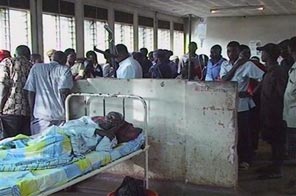Ugandans use hand tools to dig out mud; 86 dead
NAMETSI: Rescuers used hand tools Wednesday to dig through thick rivers of mud that had engulfed three villages, burying church worshippers alive and leaving dozens of students missing who had sought refuge at a hospital.
People wailed and wept in the village of Nametsi as rescuers dug through the mud. Kevin Nabutuwa of the Uganda Red Cross said the death toll had reached at least 86 with hundreds unaccounted for early Wednesday.
Rescuers recovered the body of a 12-year-old girl who was among a group of more than 50 missing students, Nabutuwa said.
"We expect to recover more bodies as time goes on. But the exercise is slow because we are using hoes to dig the dead bodies out of the thick mud," said Nabutuwa.
Five bodies lay beside the dirt track leading to the village, waiting to be claimed by relatives. Scores of soldiers helped rescue efforts ahead of an expected visit by President Yoweri Museveni.
The mudslides swamped the region late Monday and Tuesday after torrents of rain pounded the mountainous region known as Bududa, 170 miles (275 kilometers) east of Kampala, the capital. Police, army soldiers and aid workers have been working to recover bodies in the remote villages, which officials said were a three-hour walk from a main highway.
The region has long suffered from landslides but rarely has the death toll been so high. Officials on Tuesday said more than 250 people were feared missing.
"All of a sudden the church collapsed. Mud covered the whole place. Five people seated next to me died. I only survived because my head was above the mud," James Kasawi, 20, told The Associated Press from a hospital in Bududa, where he was recovering from a broken leg and arm.
Another survivor, Mohamed Mudindi, described a scene of panic.
"I was up in the mountain standing then I heard a loud bang then we saw smoke, then the landslide," he said. "So we started running away from the scene, we then went to the rescue place leaving many people and animals behind. So when we went back most of our people were gone."
Unusually heavy rains also battered eastern Uganda in 2007 and forced 2,000 people from their homes and affected 50,000 people in what humanitarian officials said were the worst rains in 35 years. Landslides were reported in some areas. Nearly 4,000 households said their crops were damaged and flood waters contaminated springs, bore-holes and wells for thousands of Ugandans. Many people reported being too afraid to use latrines in case they collapsed.
The conditions prompted aid agencies to raise alarms about the heightened risk of malaria, diarrhea, skin diseases, chest infections and intestinal diseases.






